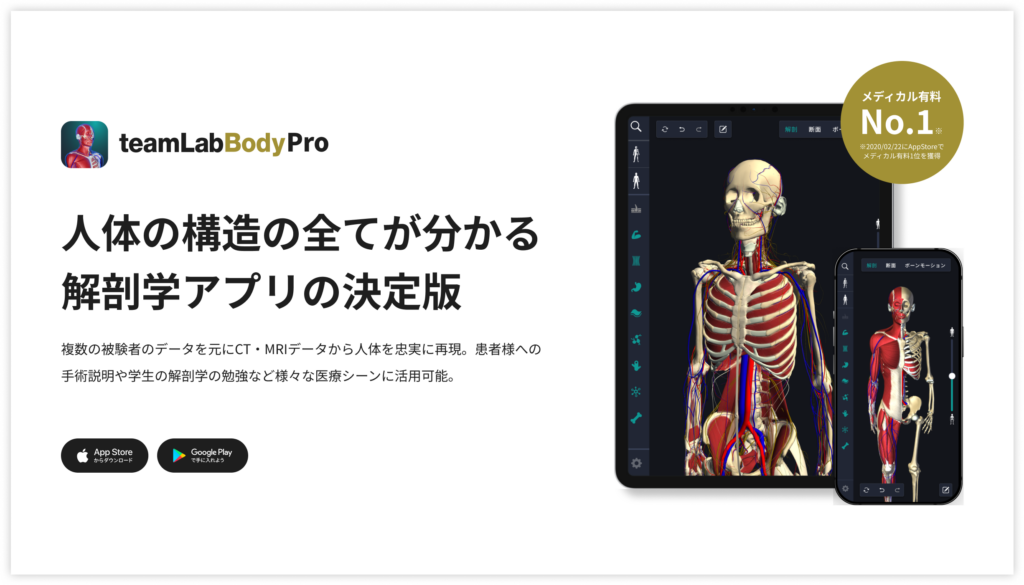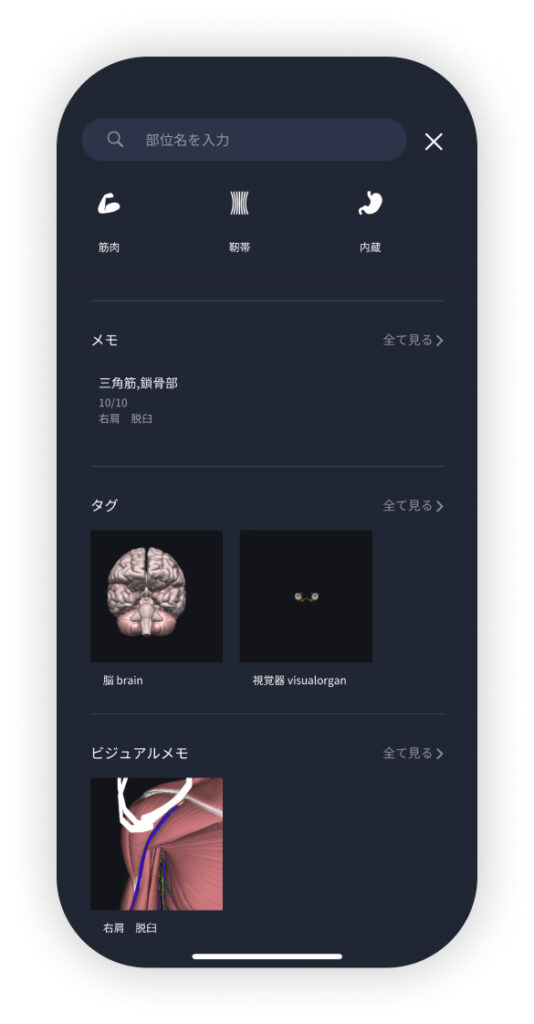beginning
In this article, I will explain effective study methods, starting with knowledge of specialized parts in human anatomy.
In human anatomy, it is necessary not only to memorize the names of various organs, muscles, and bones, but also to remember where they are located in the body. Therefore, it is necessary to learn as efficiently as possible.
I hope you will deepen your understanding even a little by reading this article and using the app.
Now, I'll explain the details about the “cleft epiglottis muscle” and how to study human anatomy.
teamLab Body Pro Free Download
A 3D anatomy app that shows all the structures of the human body
Download teamLab Body Pro here!

What is the cleft epiglottis muscle?
The anatomy application allows you to view a selection of anatomy 3D models. In this model, there are various observation methods such as surfaces, cross-sections, and nervous systems. This time, I'll explain using an anatomy application.
About epiglottis muscle

Ariepiglottic muscle (Ariepiglottic muscle) is one of the muscles involved in laryngeal movement and vocal cord control. This muscle runs from the apical cartilage towards the epiglottis and coordinates epiglottic movements.
Its main function is to close the epiglottis during the swallowing process, preventing food and liquid from entering the trachea. The clavicular epiglottis muscle works in coordination with the thyroepiglottis muscle and the lateral cricoid lateralis muscle to show effective swallowing and speech control.
The nerve is innervated by the recurrent laryngeal nerve of the vagus nerve. If the function of the cleft epiglottis muscle is impaired, swallowing difficulties and risk of aspiration increase, and difficulty speaking may appear.
Study points
1. Using visual materials: Use detailed anatomical diagrams and 3D models to confirm the exact position and running of the cleft epiglottis muscle. Understand the muscular pathway from lanceolate cartilage to epiglottis. Understand other coordinating muscles and parts associated with laryngeal structures.
2. palpation: Swallow while touching the outside of the throat with your finger, and indirectly sense the movement of the throat. Direct palpation is difficult, but we understand muscle feel through changes in throat movements.
3. Movement observation: Use a mirror to observe laryngeal movements during swallowing and speech. In particular, the movement of the lanceolate epiglottis muscle is visually checked during swallowing. Understand how muscles work by observing others' movements.
4. Understanding features: Understand the specific role of the cleft epiglottis muscle in how it pulls down the epiglottis and is involved in swallowing and vocalization. Learn the movement of the epiglottis and the swallowing process in detail.
5. Learning clinical symptoms: Learn about symptoms and treatment methods for cleft epiglottis muscle dysfunction (e.g. nerve palsy or laryngeal injury). Understand the causes and countermeasures for dysphagia and aspiration.
How to study human anatomy
I will explain specific study methods using human anatomy applications.
Check your past learning history and practice repeatedly
Here are the steps to check your anatomy learning history and practice iteratively effectively.
1. Check your learning history in the app
Reviewing your learning history with the application is an important step in effectively advancing anatomy learning. First, launch the app and go to the learning history section from the main menu. Many anatomy apps are designed to show your progress in the form of graphs and lists, so you can visually check which parts you've learned about and how much time you've spent.
By using this data, you can understand which areas you have strengths in and where you need to spend more time and effort. We also recommend using a dedicated tag or notebook function to mark areas you are particularly weak at or where you need to relearn. Regularly checking your learning history and looking back on past learning content will lead to efficient review and deepening understanding.
2. Make a plan for iterative learning
Making an efficient repetitive learning plan based on learning history is extremely effective in promoting knowledge retention. First, identify weak points and areas where you need to relearn. Next, arrange these study items into a weekly or monthly calendar and create a specific study schedule. By proceeding in a planned manner, you can learn each part evenly and avoid packing in a large amount of information at once.
Using a task management app or digital calendar to set study reminders is effective. Also, it's important to have the flexibility to regularly review progress and revise plans as needed. By having goals and proceeding with your studies in a planned manner, you can efficiently acquire anatomical knowledge.
3.Use 3D features to learn visually
By utilizing the 3D function, learning anatomy is easier to understand visually. The 3D model shows the structure of the human body three-dimensionally, and each part can be observed in detail. This makes it possible to intuitively grasp positional relationships between deep muscles and organs that are difficult to capture in a planar view. For example, you can learn even the smallest details by rotating specific muscles and bones and zooming in and out.
Also, there are many apps that have the function of displaying cross-sectional views of each part using a 3D model, which is useful for deepening understanding of internal structures. This diversity of visual information helps with memory retention and improves immediate responsiveness in tests and practice situations. By utilizing the 3D function and learning visually, you can learn anatomy knowledge more deeply and efficiently.
Use the memo function concretely

Make notes so you don't forget the things and points you've noticed while studying. The memo function can be used for different purposes, such as inputting text, saving images, and writing memos. Tag your notes to make them easier to review later.
Test your learning regularly in the form of quizzes
Regularly testing what you've learned in a quiz format is a very effective way to anchor your anatomy knowledge. Quiz-style tests help you objectively grasp your level of understanding and areas you lack while repeating knowledge.
For example, by using a learning app to conduct quizzes every specific period, you can reconfirm what you've learned and strengthen your memory. There are a wide range of quiz formats, such as multiple choice questions, fill-in-the-blank questions, and short answer questions, and each helps understanding from a different angle and develops the ability to utilize various types of knowledge.
Get feedback
If possible, get feedback from other learners and experts. It helps you find your own gaps in understanding and areas for improvement. You can also keep yourself motivated to learn by regularly testing yourself. Feeling a sense of accomplishment and progress increases motivation for continuous learning.
summary
This time, I explained how to study “cleft epiglottis muscle” using an application!
Thank you for reading this far.
I would be happy if reading this article helped you learn about anatomy.
Learning is a long, never-ending journey, but I sincerely wish you all the best. Let's continue to study together and work hard for the national exam!
Please look forward to the next blog.
teamLab Body Pro Free Download
A 3D anatomy app that shows all the structures of the human body
Download teamLab Body Pro here!





